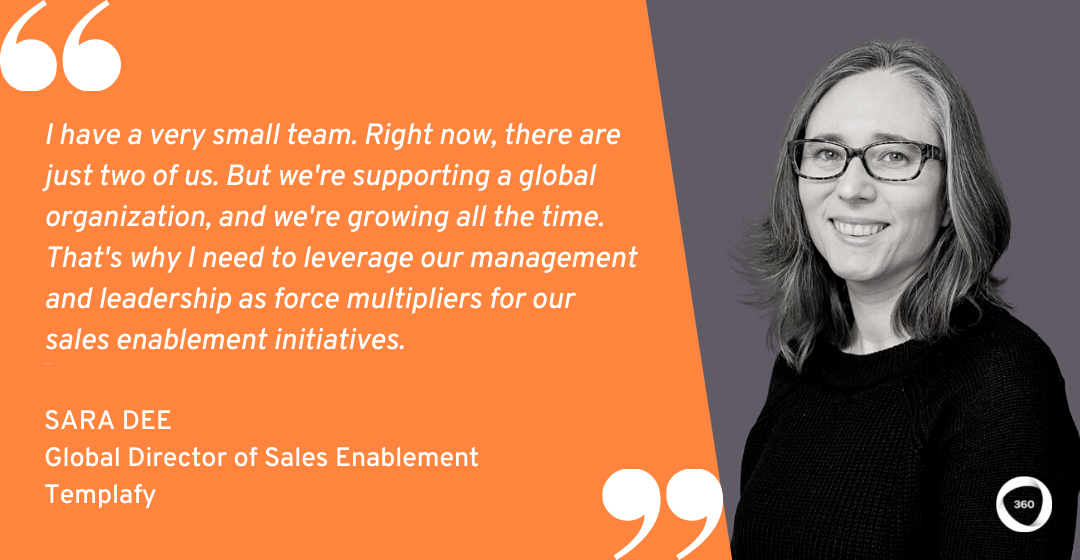
How Templafy Supports a Global Sales Presence With a 2-Person Sales Enablement Team
In every business, sales enablement is called upon to make an outsized impact. Enablement teams are usually modest in size, but they play a critical role in building your customer base, accelerating revenue growth, and getting your product out into the world.
So, how can lean sales enablement teams make sure they’re making the biggest possible impact? How can they champion the right enablement strategy to support their reps?
To answer these questions and more, I sat down with Sara Dee, Global Director of Sales Enablement at Templafy. Sara was kind enough to chat to me about how Templafy’s 2-person enablement team turns managers into sales enablement force multipliers.
We started our conversation by talking about the challenges of sales enablement at Templafy.
Small team, big job: what sales enablement looks like at Templafy
As Sara explains, cloud-based content management system Templafy has a lean and centralized sales enablement team. That’s why it’s so important to use their sales managers as force multipliers within their sales enablement strategy.
“I have a very small team,” says Sara. “Right now, there are just two of us. But we’re supporting a large global organization, and we’re growing all the time. That’s why I need to leverage our management and leadership as force multipliers for our sales enablement initiatives.”
Alongside this strategy, Sara is also focused on an often overlooked part of sales enablement: training sales managers. “If you think about the career progression of sales managers, a lot of them don’t receive any formal training on being coaches, leaders, or even managers.”
“I really believe we need to partner with our sales leaders to help inform our enablement strategy, and that we arm them with the tools and the knowledge they need to be force multipliers within their teams. That means giving them the right opportunities for their own development, and leveraging them to help us with our enablement programs.”
So, how exactly does Templafy partner with their sales managers to create this leader-first sales enablement?
Related: Amazon’s 4-Step Playbook for Targeted Sales Enablement
You can never have enough expert insights! Check out our ebook to find out How L&D Can Help You Build a Strong Company Culture
Templafy’s 3 key steps for leader-first sales enablement
According to Sara, while creating leader-first sales enablement might seem daunting, it all comes down to three key steps. “When I think about leaders-first enablement I really think of three things: training, communication, and resources.”
#1: Training managers in Templafy’s sales enablement coaching framework
“The first thing we did at Templafy was partner with a third-party company to train all of our sales managers on our coaching framework,” says Sara. “This meant all of our managers were certified sales coaches.”
“That gives us a common language across the team on coaching, and it helps us build a culture of coaching, so that our sales team understands they’re being coached, and they know what to expect from the experience. It also means that our managers are able to be effective.”
#2: Communicating with managers first
“With sales enablement, we also make sure we communicate with our managers first,” says Sara. “This means everything goes to them for input before it goes to their team. This way, they’re able to orientate themselves around it and get behind it a lot faster. This ensures we have buy-in, and we’re giving clear direction to people.”
“A really good example of that is, Templafy recently rolled out a new positioning and value proposition. The team needed to be able to master the value proposition, and to develop their own 30-second pitch on who we are and why we matter. But first, we rolled this out to sales managers to get their input and make sure we were all on the same page.”
#3: Providing sales managers with the right resources and coaching
To stick with the example of Templafy’s new value proposition, Sara knew she needed to follow up with the right resources for sales managers to play a key role in sales enablement.
“We trained our managers first,” she says. “Then, we gave them activities and resources to run small group sessions with their teams while providing support and meeting specific needs.”
“When we build enablement programs, we also build a coaching resource, so that our managers know what results they should be looking for, the effort it’s going to take to reach those results, and the knowledge and skills our reps need.”
By including these coaching resources, Templafy helps to ensure their sales enablement is as consistent as possible. “We really clarified for them the result we were looking for: everyone should be able to deliver this 30-second pitch, here’s the effort required, here are the knowledge and skills they need, and here are the resources to make this happen.”

This 3-step approach helps Sara and her team make the most of limited sales enablement resources within Templafy. It also helps them avoid some of the classic pitfalls of delivering enablement via large-scale synchronous meetings.
“With these three steps, we were able to support our managers to roll out this training to their teams. Because with an initiative like this, a large 100+ person meeting isn’t going to do it.”
So, how is Sara measuring and evaluating the wider impact of Templafy’s strategy?
Related: 3 Essential Tips to Create Engaging Training for Your Sales Teams
When I think about leaders-first enablement I really think of three things: training, communication, and resources.
Evaluating the impact of Templafy’s sales enablement strategy
“The question of our impact in sales enablement is really multifaceted, but it all starts with feedback,” says Sara. “I’m a big believer in feedback at all levels.”
But Sara also went beyond just collecting feedback–she also experienced this sales enablement strategy firsthand. “We sought feedback from our managers on how these sessions are going, and we attended these sessions ourselves to see how they were going and support them in delivering the training.”
“It’s also about listening,” says Sara. “Right now, I’m on a listening tour to find out whether the team has been implementing and applying this messaging in their sales calls. If not, what’s the blocker? What else do people need from an enablement standpoint? What’s missing here?”
“This is giving me a good sense of whether our managers are coaching their teams effectively, and whether the team feels like they have the tools they need. Are they applying the skill and the knowledge that we gave them? Are we achieving our result where everyone has a strong grasp of the pitch?”
For Sara, it’s important to have clear expected outputs and behaviors at every level of the sales enablement strategy. Sometimes, assessing these outputs is as simple as asking the right questions. “When I go back to the office, I’m going to start randomly asking people: ‘Who is Templafy? What do they do?’ Then I’ll hang back and see what they say.”
“Large group sessions or eLearning just on their own aren’t the most collaborative or engaging modalities for changing behavior or learning new skills. But if we create a culture of coaching and peer learning, that equips our managers to be multipliers of what we’re doing. This way, we can make sure we’re having an impact.”
Related: 3 Data-Based Ways to Prove Training ROI (+ Free Training ROI Calculator)
Large group sessions or eLearning just on their own aren’t the most collaborative or engaging modalities for changing behavior or learning new skills. But if we create a culture of coaching and peer learning, that equips our managers to be multipliers of what we’re doing.
Building stronger communication in sales enablement
Alongside measuring the impact of Templafy’s 3-step approach, Sara is also focusing a lot on improving the company’s communication in sales enablement over the long-term.
“Right now, I’m focused on really effective communication,” says Sara. “Not everyone is a great communicator, and a lot of times, especially in enablement, we can get in the weeds. We know what we’re trying to relay, especially when we’re training on things like a product launch. But we don’t always step back and think, how do I break this down so that it’s really clear? Who am I communicating to, exactly?”
“This is an area where my team and I could definitely improve a bit, especially in the world of sales where it’s important to deliver the right information at the right time. If you’re selling, you care about the deal and the meeting you’re on right now. You may not care about something that doesn’t impact you right now but doesn’t impact you for a month.”
“That’s why really robust communication skills are so important, because it helps us understand more about exactly who we’re talking to, and why. For me, that’s a crucial part of sales enablement.”
We know what we’re trying to relay, especially when we’re training on things like a product launch. But we don’t always step back and think, how do I break this down so that it’s really clear? Who am I communicating to, exactly?
Thanks again to Sara for sharing her story!
While you’re here, check out my expert interviews with Jess Almlie of WEX Benefits Division about her Collaborative Learning techniques to capture top sales rep expertise, and with Heidi Kirby of Datatrak International about her 4-step playbook for great customer learning.
Want more peer insights on transforming workplace learning? Check out #CLOConnect, our interview series with top L&D leaders on driving growth and scaling culture through Collaborative Learning. Or you can subscribe (below 👇) to our weekly newsletter to receive our latest posts directly in your inbox.


